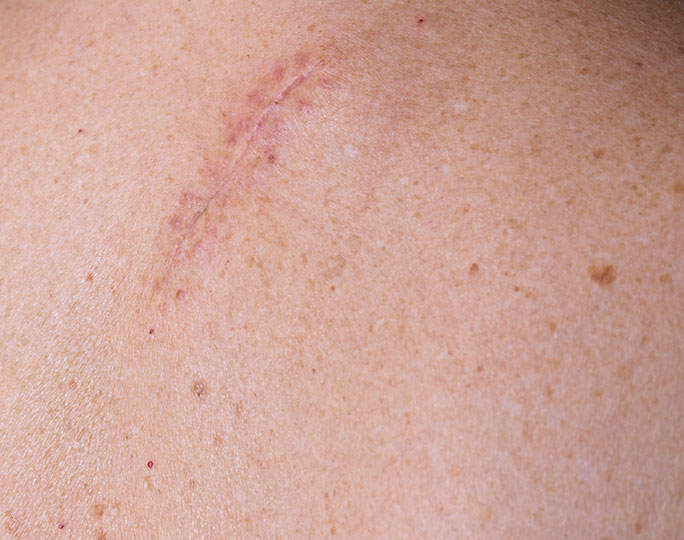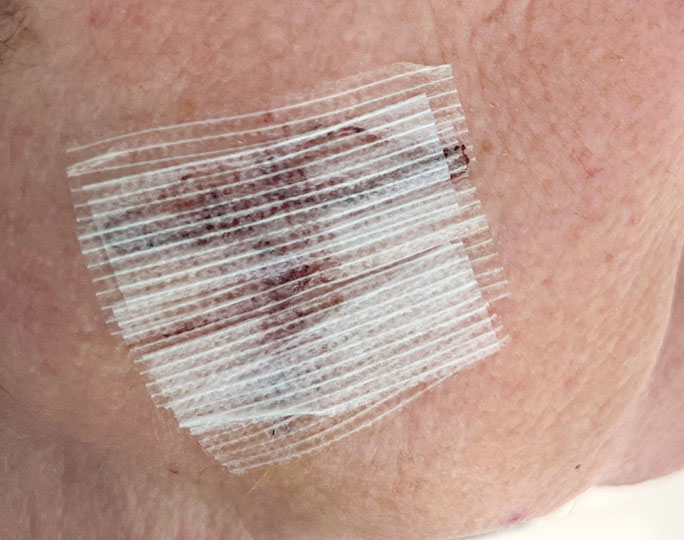
Mohs surgery is commonly used to treat basal and squamous cell skin cancers. Though it is considered the “gold standard” in skin cancer treatment, it comes with many unknowns for both the person having the surgery and the doctor performing it.
Risks and unknowns of Mohs surgery to people with skin cancer
If your dermatologist recommends Mohs surgery to treat your skin cancer, it is important to learn all you can about Mohs. There are many unknowns while the surgery is performed, but it may help to know generally how it is done:
- Depending on where the cancer is, you will sit or lie down for the surgery, wearing either your clothes or a hospital gown.
- The surgeon looks at the cancer and circles the area to be removed with a special pen.
- You will be awake for the surgery but a medicine is used to numb the area being cut out so that you do not feel any pain.
- When the skin is numb, the surgeon cuts out the skin cancer and a small area of normal looking skin around it. This may take about 10 to 20 minutes.
- While the skin is sent to the lab, special bandages, called a pressure dressing, are put on the skin to help stop the bleeding and help you wait comfortably.
- The skin is looked at under a microscope in the lab. This can take 40 to 50 minutes.
- If skin cancer cells are found on the edge of the skin removed, the surgery is done again. It will be repeated as many times as needed until no more skin cancer cells are seen under the microscope. Every cancer is different and there is no way to know how deep the cancer is, how much skin will need to be removed, or how long the surgery will take before it starts. Most people will need 1 to 3 surgeries within the same day to fully remove the cancer.
- When the skin is cancer-free, the surgeon will talk about the options for closing the wound and reconstructive surgery, if needed. You are given care and follow-up instructions and can go home.
Going into surgery, you will not know how long it will take and how many stages will be needed. Then, there is the question of how large the wound will be and how it will be closed, which will factor into the scar that may be left. For about 80% of people who have Mohs in one study, the scar that was left was larger than they thought it would be, based on the conversation they had with their surgeon before surgery. There is also no way to know if you will need plastic or reconstructive surgery. About 15% of people who have Mohs surgery will need reconstruction.
All these unknowns can cause stress, worry, or fear. Be honest with your surgeon about these concerns and get as much information as you can about the parts of the surgery that bother you. Talk with him or her about what you can do before surgery to prepare, and what steps you can take to have the best recovery. You should ask questions, like:
- What have other people done to make it easier to wait during the stages of surgery?
- If my wound is large and needs reconstructive surgery, can it be done that day?
- How long will I need to keep the bandages on the wound?
- If my scar is in an area that people will see, when can I have plastic surgery to fix it?
It is also okay if these unknowns make you question whether Mohs is the right treatment for you. It is okay to ask questions and learn about your other treatment options, or even to get a second opinion.
- Which treatment options leave little to no scars?
- Are there treatments that allow me to keep going to work?
- Which treatments let me keep taking my regular medicines and have the lowest risk for infection and bleeding?
- Are there options for treating more than one skin cancer at the same time?
Mohs surgeons are used to these unknowns
Mohs surgeons are dermatologists who receive special training from either the American College of Mohs Surgery or the American Society for Mohs Surgery to become a cancer surgeon who performs Mohs surgery. Through this training and their experience, they are used to the unknowns that may trouble many people having Mohs surgery.
It is important that you feel comfortable and confident in your Mohs surgeon. Search for a fellowship-trained Mohs surgeon in your area. He or she should be open to any questions you have about your cancer and its treatment. Together, you can come up with a plan and think through options for how to handle the things that concern you.
Finding the right treatment for you
Mohs surgery may not be the only treatment option that will work to cure your skin cancer. There are nearly 10 surgery-free treatment options. For example, Image-Guided SRT is a type of treatment that uses X-ray energy to kill cancer cells without surgery, bleeding, or wounds. It uses ultrasound images to measure the size of your cancer and come up with a treatment plan made just for you. The ultrasound images also let you watch the cancer shrink with each visit until it is gone.
If a treatment that has more of a plan and fewer unknowns feels better for you, talk with your dermatologist. Finding out that you have skin cancer can be scary enough. Treating your skin cancer should be a relief, not another worry.


